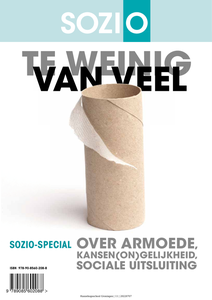For over 30 years, the concept of home has been a popular, yet contested subject of research for scholars from different disciplines, e.g. architecture, philosophy, sociology, psychology and cultural studies. In line with this multifaceted, interesting subject, quite some studies have been devoted to the subject of homemaking.However, when reviewing the literature on home and homemaking, a great deal of scholars seems to have overlooked to date the home situation, and thus the homemaking activities and practices of single person households, or so called ‘solo livers’. This is remarkable because the number of single person households is increasing worldwide, as different recent studies show e.g. (Palmer G. , 2006), (Klinenberg, 2012), (Jamieson & Simpson, 2013). The aim of this working paper – which is part of a PhD proposal in progression – is to address the homemaking process from the perspective of solo living people in the geographical setting of the Provence of Groningen, in the northern part of the Netherlands. An underlying assumption is that by focusing on the homemaking of solo living people, i.e. on the individual level, this typical human phenomenon can be studied in its ‘purest form’.In the paper on homemaking in low-cost areas, Aziz & Ahmad (2012) connect the concepts of appropriation, attachment and identity as homemaking mechanisms, through which residents strive to achieve satisfaction and turn the surrounding area into their home. Aziz & Ahmad seek to identify specific behavioural components, called ‘attributes’, that belong to these three different concepts, in which they make a distinction between physical and social attributes. This focus of this paper is on the concept of appropriation as homemaking mechanism and how this concept can be refined to serve as conceptual framework.
DOCUMENT
Background: The strain on health care services is increasing due to an ageing population and the increasing prevalence of chronic health conditions. eHealth could contribute to optimise effective and efficient care to older adults with one or more chronic health conditions in the general practice. Aim: The aim of this study was to identify the needs, barriers and facilitators amongst community-dwelling older adults (60þ) suffering from one or more chronic health conditions, in using online eHealth applications to support general practice services. Methods: A qualitative study, using semi-structured followed by think-aloud interviews, was conducted in the Netherlands. The semi-structured interviews, supported by an interview guide were conducted and analysed thematically. The think-aloud method was used to collect data about the cognitive process while the participant was completing a task within online eHealth applications. Verbal analysis according to the Chi approach was conducted to analyse the think-aloud interviews. Findings: A total of n = 19 older adults with a mean age of 73 years participated. The ability to have immediate contact with the GP on important health issues was identified as an important need. Identified barriers were non-familiarity with the online eHealth applications and a mismatch of user health needs. The low computer experience resulted in non-familiarity with the online eHealth applications. Faltering applications resulted in participants refusing to participate in the use of online eHealth applications. Convenience, efficiency and the instant availability of eHealth via applications were identified as important facilitators. Conclusion: To improve the use and acceptability of eHealth applications amongst older adults in the general practice, the applications should be tailored to meet individual needs. More attention should be given to improving the user-friendliness of these applications and to the promotion of the benefits such as facilitating older adults independent living for longer.
DOCUMENT

Recensie van het boek ‘De nieuwe groei heet krimp : een perspectief voor Parkstad Limburg’ van J. Latten en S. Musterd (red.)
DOCUMENT

Een steeds groter deel van alle betalingen vindt elektronisch plaats. De verschillende partijen die actief zijn op het terrein van elektronisch betaalverkeer, zijn erop gericht het elektronisch betalen in de toekomst efficiënter en veiliger te maken. De consument is echter opvallend afwezig in deze ontwikkeling.
LINK
Deze bijdrage brengt op basis van de cijfers van 2002 en eerdere gegevens uit Eindhoven een aantal aspecten van de omvang en aard van eenzaamheid in de stad in beeld. De oorzaken en gevolgen van eenzaamheid en de rol die sociale netwerken daarbij spelen worden in beeld gebracht.
DOCUMENT
In het welvarende Nederland groeit een op de dertien kinderen en jongeren op in armoede. Armoede heeft nadelige gevolgen voor de ontwikkeling en kansen van kinderen. Professionals in het sociaal domein kunnen veel voor deze kinderen, jongeren en hun ouders betekenen. De SOS aanpak bij kinderarmoede maakt concreet hoe professionals deze rol kunnen vormgeven.
DOCUMENT

Mantelzorg is een van de kernpunten van de overheid. Zorg voor elkaar is een belangrijke troef bij het beteugelen van de toenemende zorgkosten door vergrijzing. Maar zijn de verwachtingen realistisch? De Eerstelijns analyseert. Mantelzorg komt meestal voor rekening van familieleden. Vrijwilligers, buren en vrienden hebben een bescheiden, ondersteunende rol. Er zijn diverse onderzoeken naar mantelzorg uitgevoerd. In dit artikel beschrijven we de conclusies op hoofdlijnen.
DOCUMENT

In opdracht van de Vereniging Dorpsbelangen Schouwerzijl is onderzoek gedaan onder alle inwoners van Schouwerzijl hoe zij hun leefomgeving waarderen. In dit onderzoek zijn vier domeinen betrokken die bepalend zijn voor de beleving van leefbaarheid: het wonen en de woonomgeving, het voorzieningenniveau, het sociale klimaat en het organiserend vermogen van de dorpsgemeenschap. Het doel van dit onderzoek was om de Vereniging Dorpsbelangen Schouwerzijl te adviseren over de inhoud van een nog op te stellen dorpsvisie. In het onderzoeksrapport staat het advies voor een zeer korte dorpsvisie met 10 belangrijke waarden en voorbeelden van uitvoeringshandelingen.
DOCUMENT

Ontwikkeling in denken over generaties, samenleving en manieren van begrijpen.
DOCUMENT